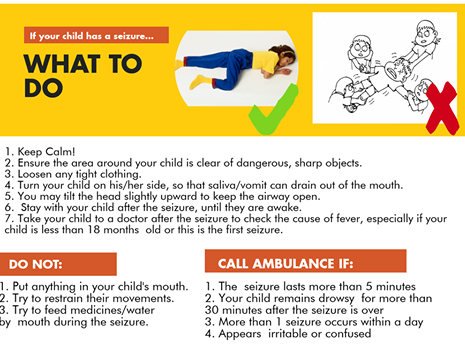What are febrile seizures?
Febrile (fever related) seizures are convulsions that can happen when a young child has a fever above 100.4°F (38°C). The seizures usually last for a few minutes and stop on their own.
Febrile seizures can look serious, but most stop without treatment and don't cause other health problems. Some kids might feel sleepy after one, while others feel no lasting effects.
Who gets febrile seizures?
Febrile seizures happen in kids 6 months to 5 years old. They're most common in toddlers 12–18 months old. Most children outgrow having febrile seizures by the time they are 5 years old.
Kids are more likely to have a febrile seizure if:
- They have another member in the family who has febrile seizures.
- They’ve already had one previously. About 1 in every 3 kids who have had one febrile seizure will have another, usually within 1–2 years of the first.
- They had a first febrile seizure when they were younger than 15 months old.
Febrile seizures are not considered epilepsy (seizure disorder). Kids who have a febrile seizure have only a slightly increased risk for developing epilepsy.
What are the symptoms of Febrile Seizures?
There are two types of febrile seizures:
1. Simple febrile seizures are most common. They’re usually over in a few minutes, but in rare cases can
last up to 15 minutes. During this type of seizure, a child may:
- rythmically shake or jerk all the four limbs
- roll the eyes
- become unconscious
- urinate (pee) during the seizure
- vomit after the seizure ends
2. Complex febrile seizures are uncommon and may need review by a pediatric neurologist and further investigations.
During this type of a seizure:
- the seizure can last longer than 15 minutes.
- happen more than once in 24 hours
- involve movement or twitching of only one part or one side of the body
What causes Febrile Seizures?
No one knows why febrile seizures happen. But evidence suggests that they’re linked to some viruses and the way that a child's developing brain reacts to high fevers. In some families, different members may be affected by it, implying a genetic predisposition.
What to do when your child has a febrile seizure?
If your child has a febrile seizure, stay calm and:
- Gently place your child on the floor or the ground.
- Remove any nearby objects.
- Place your child on his or her side (recovery position) as the seizure comes to an end as it prevents choking on secretions or vomit.
- Loosen any clothing around the head and neck.
- Watch for signs of breathing problems, including bluish color in the face.
- Try to keep track of how long the seizure lasts.
- If possible, ask a family member to video record the seizure.
If the seizure lasts more than 5 minutes, or your child turns blue, it may be a more serious type of seizure — call 108 right away.
It’s also important to know what you should not do during a febrile seizure:
- Do not try to hold or restrain your child.
- Do not put anything in your child’s mouth.
- Do not try to give your child fever-reducing medicine by mouth.
- Do not try to put your child into cool water to cool off, or pour water on to their head.
- Do not close eyes, make your child sniff shoes or onions.
When the seizure is over, take your child to the nearest children’s hospital to see a pediatrician. In some cases, they may refer the child to a pediatric neurologist for review, specially if they have had a complex febrile seizure.
How to manage the fever?
- The doctor may recommend the standard treatment for fevers, which is paracetamol and in some cases ibuprofen. Ibuprofen should be given only on advice of a pediatrician. The doses of paracetamol should be optimal for weight and age.
- It is wise to strip the child off the clothes and keep him in a well ventilated room. Covering the child with more blanket or clothes during a fever as they are experiencing a chill is not helpful.
- Similarly, pouring water over the body during a fever is likely to cool the external skin, making the internal core temperature even higher and risking occurrence of a febrile seizure. Hence, tap water or cold sponging is not recommended any more in routine fever.
In some cases, the doctor may prescribe a medication to be given when the child has an intercurrent illness and is showing features of fever, to prevent occurrence of a febrile seizure. Such medications, like clobazam, is usually given for 3 days and do not cause any long term neurodevelopmental problems.
If the child has experienced a longer seizure, or stay far away from hospital facility, the doctor may train the parents to give a medication called midazolam through the nose. This medicine given correctly is able to stop the seizure from lasting for long.
When to call 108?
Get emergency medical care if your child:
- has a febrile seizure that lasts longer than 5 minutes and does not respond to nasal midazolam
- the seizure involves only some parts of the body instead of the whole body
- has trouble breathing or turns blue
- isn’t responding normally an hour after the seizure has stopped
- has another seizure within 24 hours
A child who has missed getting some vaccines and has a febrile seizure could have a higher risk for meningitis. Get medical care right away if your child has any signs of meningitis, such as:
- a stiff neck
- vomiting, poor eating
- in babies, a bulging soft spot on the head
- drowsiness which is excessive
Febrile seizures can be scary to see. But they’re fairly common and not usually a symptom of serious illness.


